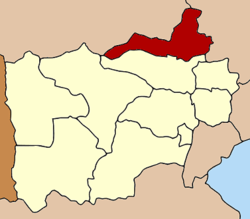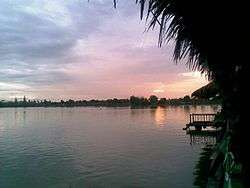Ban Pong District
| Ban Pong บ้านโป่ง | |
|---|---|
| District (Amphoe) | |
|
Lakeside restaurants at sunset. Bueng, Nong Kop, Ban Pong District | |
 District location in Ratchaburi Province | |
| Coordinates: 13°48′51″N 99°52′16″E / 13.81417°N 99.87111°ECoordinates: 13°48′51″N 99°52′16″E / 13.81417°N 99.87111°E | |
| Country | Thailand |
| Province | Ratchaburi |
| Area | |
| • Total | 366.6 km2 (141.5 sq mi) |
| Population (2543) | |
| • Total | 157,689 |
| • Density | 430.1/km2 (1,114/sq mi) |
| Time zone | ICT (UTC+7) |
| Postal code | 70110 |
| Geocode | 7005 |
Ban Pong (Thai: บ้านโป่ง, pronounced [bâːn pòːŋ]) is a district (amphoe) of Ratchaburi Province, Thailand. It is in the northeast of the province.[1]
Geography
Neighboring districts are (from the north clockwise) Tha Muang and Tha Maka of Kanchanaburi Province, Kamphaeng Saen and Mueang Nakhon Pathom of Nakhon Pathom Province, and Photharam of Ratchaburi Province.
Ban Pong District is hilly in the very western part of the district, while the eastern part is flooded plain with the Mae Klong River running through the city centre, connecting the city to the Gulf of Thailand.
History
Mon people settled in the Ban Pong area about four centuries ago. The Mon communities have maintained some of their traditions and have built their own Buddhist temples[2] Later the town attracted a great number of Chinese immigrants as well. Also many Lao Wiang communities settled in the Nong Kop sub-district of rural Ban Pong.[3]
During the construction of the Burma Railway in World War II Ban Pong was the site of one of the POW camps, Nong Pladuk Camp.[4]
Ban Pong town experienced two great fires which razed the town centre, one in 1936 and the other in 1954. The town was rebuilt in the square-grid design then fashionable, with a fountain to the south and a clock tower to the north.
Economy
Ban Pong is a railway hub, where the western railway leading to Kanchanaburi (and further to Nam Tok) splits from the southern railway leading to Singapore. Another branch connects with the town Suphanburi to the north.
As a result of high investment and fast economic development in the past decades, The town stands as one with the highest GDP per capita in western Thailand, well above national average. It is also experiencing de-industrialisation of labour-intensive industries such as canning and sugar refining. There is a large abandoned canning factory in Ban Pong town. The town is now experiencing a boom in more highly skilled industries such as auto parts, petrochemical, and food industries, with more than 70 percent of Thai buses and coaches manufactured in Ban Pong. There is the biggest paper making complex in Thailand north of the town.
As of June 2014, the National Statistics Bureau reported Ban Pong's annual GDP per capita (nominal) at US$9,623 and its annual GDP per capita (PPP) at US$24,000 compared with Thailand's US$5,675 and US$14,136 respectively.
Sights
West of the town Ban Pong is Wat Muang, a local centre of the Mon community. There is also a large Roman Catholic church building and a large Buddhist temple.
Administration
The district is divided into 15 sub-districts (tambon), which are further subdivided into 182 villages (muban). Ban Pong itself is a town (thesaban mueang) which encompasses tambon Ban Pong. Another town in the district is Tha Pha (Thai: เทศบาลเมืองท่าผา) whose administrative area covers the entire sub-district Tha Pha and parts of Pak Raet.
There are a further four townships (thesaban tambon) including:
1.Krachap (Thai: เทศบาลตำบลกระจับ) covers parts of Nong O and Don Krabueang
2.Huai Krabok (Thai: เทศบาลตำบลห้วยกระบอก) covers parts of Krap Yai
3.Krub Yai (Thai: เทศบาลตำบลกรับใหญ่)
4. Boek Phrai (Thai: เทศบาลตำบลเบิกไพร)
and 14 other tambon administrative organizations (TAO) responsible for the non-municipal areas.
| No. | Name | Thai name | ||||||
|---|---|---|---|---|---|---|---|---|
| 1. | Ban Pong | บ้านโป่ง | 9. | Nakhon Chum | นครชุมน์ | |||
| 2. | Tha Pha | ท่าผา | 10. | Ban Muang | บ้านม่วง | |||
| 3. | Krap Yai | กรับใหญ่ | 11. | Khung Phayom | คุ้งพยอม | |||
| 4. | Pak Raet | ปากแรต | 12. | Nong Pla Mo | หนองปลาหมอ | |||
| 5. | Nong Kop | หนองกบ | 13. | Khao Khlung | เขาขลุง | |||
| 6. | Nong O | หนองอ้อ | 14. | Boek Phrai | เบิกไพร | |||
| 7. | Don Krabueang | ดอนกระเบื้อง | 15. | Lat Bua Khao | ลาดบัวขาว | |||
| 8. | Suan Kluai | สวนกล้วย |
Transport
Railway
Ban Pong Railway Station is the main railway station in the district, in Ban Pong Town. There are three other railway stations in the district:
See also
References
External links
 Media related to Ban Pong District at Wikimedia Commons
Media related to Ban Pong District at Wikimedia Commons- Australian Prisoners of War (POWs) Ban Pong, Thailand
